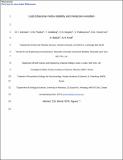| dc.contributor.author | Knoll, Andrew Herbert | |
| dc.contributor.author | Johnston, David T | |
| dc.contributor.author | Poulton, S. W. | |
| dc.contributor.author | Goldberg, T. | |
| dc.contributor.author | Sergeev, V. N. | |
| dc.contributor.author | Podkovyrov, V. | |
| dc.contributor.author | Vorob’eva, N. G. | |
| dc.contributor.author | Bekker, A. | |
| dc.date.accessioned | 2013-07-08T14:52:29Z | |
| dc.date.issued | 2012 | |
| dc.identifier.citation | Johnston, David T., S. W. Poulton, T. Goldberg, V. N. Sergeev, V. Podkovyrov, N. G. Vorob'eva, A. Bekker, and Andrew Herbert Knoll. 2012. Late Ediacaran redox stability and metazoan evolution. Earth and Planetary Science Letters 335-336:25-35. | en_US |
| dc.identifier.issn | 0012-821X | en_US |
| dc.identifier.uri | http://nrs.harvard.edu/urn-3:HUL.InstRepos:10860657 | |
| dc.description.abstract | The Neoproterozoic arrival of animals fundamentally changed Earth's biological and geochemical trajectory. Since the early description of Ediacaran and Cambrian animal fossils, a vigorous debate has emerged about the drivers underpinning their seemingly rapid radiation. Some argue for predation and ecology as central to diversification, whereas others point to a changing chemical environment as the trigger. In both cases, questions of timing and feedbacks remain unresolved. Through these debates, the last fifty years of work has largely converged on the concept that a change in atmospheric oxygen levels, perhaps manifested indirectly as an oxygenation of the deep ocean, was causally linked to the initial diversification of large animals. What has largely been absent, but is provided in this study, is a multi-proxy stratigraphic test of this hypothesis. Here, we describe a coupled geochemical and paleontological investigation of Neoproterozoic sedimentary rocks from northern Russia. In detail, we provide iron speciation data, carbon and sulfur isotope compositions, and major element abundances from a predominantly siliciclastic succession (spanning>1000 m) sampled by the Kel'tminskaya-1 drillcore. Our interpretation of these data is consistent with the hypothesis that the \(pO_2\) threshold required for diversification of animals with high metabolic oxygen demands was crossed prior to or during the Ediacaran Period. Redox stabilization of shallow marine environments was, however, also critical and only occurred about 560 million years ago (Ma), when large motile bilaterians first enter the regional stratigraphic record. In contrast, neither fossils nor geochemistry lend support to the hypothesis that ecological interactions altered the course of evolution in the absence of environmental change. Together, the geochemical and paleontological records suggest a coordinated transition from low oxygen oceans sometime before the Marinoan (~635 Ma) ice age, through better oxygenated but still redox-unstable shelves of the early Ediacaran Period, to the fully and persistently oxygenated marine environments characteristic of later Ediacaran successions that preserve the first bilaterian macrofossils and trace fossils. | en_US |
| dc.description.sponsorship | Earth and Planetary Sciences | en_US |
| dc.description.sponsorship | Organismic and Evolutionary Biology | en_US |
| dc.language.iso | en_US | en_US |
| dc.publisher | Elsevier | en_US |
| dc.relation.isversionof | doi:10.1016/j.epsl.2012.05.010 | en_US |
| dash.license | OAP | |
| dc.subject | evolution | en_US |
| dc.subject | animals | en_US |
| dc.subject | atmospheric oxygen | en_US |
| dc.subject | Neoproterozoic | en_US |
| dc.subject | Russia | en_US |
| dc.subject | Ediacaran | en_US |
| dc.title | Late Ediacaran Redox Stability and Metazoan Evolution | en_US |
| dc.type | Journal Article | en_US |
| dc.description.version | Accepted Manuscript | en_US |
| dc.relation.journal | Earth and Planetary Science Letters | en_US |
| dash.depositing.author | Knoll, Andrew Herbert | |
| dc.date.available | 2013-07-08T14:52:29Z | |
| dc.identifier.doi | 10.1016/j.epsl.2012.05.010 | * |
| dash.authorsordered | false | |
| dash.contributor.affiliated | Knoll, Andrew | |
| dash.contributor.affiliated | Johnston, David | |


